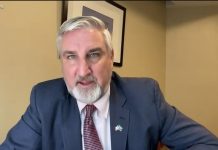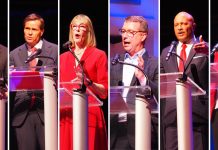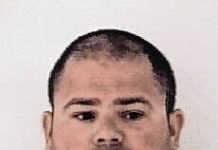Nearly 100 Columbus East students expected to learn where the three candidates for Indiana governor stood on education and other matters that are important to them.
But they also got a lesson on the art of politicians avoiding direct answers to their questions, a take-away for several of the East students in the audience and their teacher.
East was among six central Indiana high schools whose students formed the audience of the election season’s first gubernatorial debate featuring Democrat John Gregg, Republican Eric Holcomb and Libertarian Rex Bell.
Tuesday’s event at Lawrence North High School in Indianapolis was sponsored by the Indiana Debate Commission in partnership with the Indiana Kids’ Election, which holds a mock election for students statewide in grades K-12 on Election Day.
While appreciative of the opportunity, “it’s amazing how the questions that are proposed by students don’t get answered,” East government teacher Troy Buntin said after a lunchtime discussion with several of his students soon after the debate.
East senior Aaron Villiger, 17, was one of a handful of students selected to address the candidates themselves.
His question, among 112 submitted by students to the debate commission: “If you are elected, what will you do to ensure that performing arts and other arts programs continue to be encouraged in schools?”
While the candidates for governor mentioned the importance of a good education in general, and STEM (science, technology, engineering and math) programs in particular, Villiger said he was looking for some specific answers on funding for the arts — and didn’t get them.
Villiger, who plays the alto saxophone in band, worries that the arts rank lower than athletics and other programs in the minds of decision-makers, locally and statewide. He said he would like to see that change.
But he wasn’t the only student whose question during the debate wasn’t answered directly.
Isaiah Gray, an Indianapolis Arsenal High School student, asked about expansion of job programs for young people in economically depressed areas, but candidates were short on specifics, Buntin said.
Another Arsenal student, Dagoberto Morales, asked whether undocumented immigrants who want to pursue their education in Indiana colleges should be able to attend by paying in-state tuition rates.
Gregg answered affirmatively, but Bell’s answer was vague and Holcomb never committed one way or the other, Buntin said.
“I can’t solely make my (voting) decision based on what I heard today,” the East teacher said.
But having East students attend the debate will be a springboard for discussion in his government classes, Buntin said.
“Teaching government in an election year is so much fun,” he said.
Buntin and students will spend class time analyzing the candidates for governor and where they stand, which will help them decide who to vote for.
Mason Phillips, 18, already cast a vote in the spring primary — and said he will do so again in the Nov. 8 general election.
Phillips’ senior project is to encourage as many students as possible — of all ages — to vote in the same-day Indiana Kids’ Election, and he will take that message to several elementary schools and Central Middle School leading up to the election, he said.
Olivia Ortman, also 18 and a senior, said she will be casting a vote for the first time in six weeks and will support a governor that appreciates teachers and education.
“That’s something really important, especially since Indiana is lacking teachers,” she said.
With so much of the focus on the presidential election, Ortman said Tuesday’s debate was an opportunity for students to learn more about races a step down on the ballot.
“This debate experience really opened our eyes. We do have a voice. We do have a chance to use our resources and ask questions,” Ortman said.
It won’t be the only election event that Ortman gets to experience during her senior year of high school.
The capper: she will be among 10 to 15 East students who will accompany government teacher Buntin to the presidential inauguration Jan. 20 in Washington, D.C., when the nation’s 45th president is sworn in.
[sc:pullout-title pullout-title=”Indiana Kids’ Election” ][sc:pullout-text-begin]
More than 1,350 Indiana schools have signed up for their students to vote Nov. 8 in the Indiana Kids’ Election, with participation from 89 of Indiana’s 92 counties.
Indiana students will cast votes for U.S. president, the U.S. Senate race in Indiana and the Indiana governor’s race, with more than 110,000 of them expected to participate.
Schools can sign up at inkidselection.com.
[sc:pullout-text-end][sc:pullout-title pullout-title=”What’s next” ][sc:pullout-text-begin]
The Indiana Debate Commission has scheduled two more debates with the three candidates running for governor.
- 7 p.m. EDT Monday at the University of Indianapolis.
- 7 p.m. EDT Oct. 25 at the University of Southern Indiana, Evansville.
[sc:pullout-text-end]




